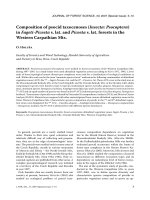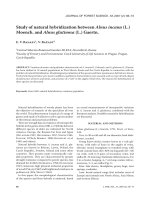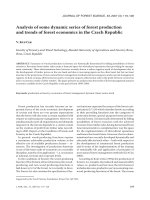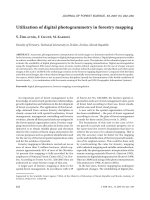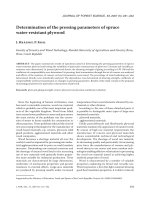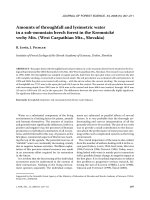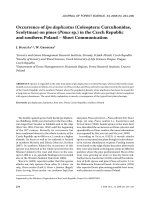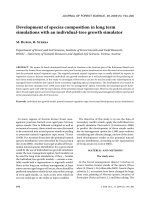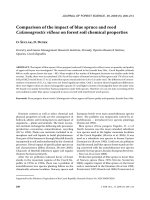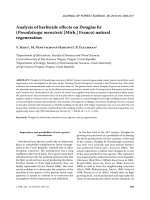Báo cáo lâm nghiệp: "Characteristics of 3rd (Querci-fageta s. lat.) and 4th (Fageta (abietis) s. lat.) vegetation tiers of north-eastern Moravia and Silesia (Czech Republic)" pps
Bạn đang xem bản rút gọn của tài liệu. Xem và tải ngay bản đầy đủ của tài liệu tại đây (944.21 KB, 13 trang )
JOURNAL OF FOREST SCIENCE, 54, 2008 (10): 439–451
Characteristics of 3rd (Querci-fageta s. lat.)
and 4th (Fageta (abietis) s. lat.) vegetation tiers
of north-eastern Moravia and Silesia (Czech Republic)
O. Holuša1,2, J. Holuša2, Sr.
1
Faculty of Forestry and Wood Technology, Mendel University of Agriculture and Forestry in Brno,
Brno, Czech Republic
2
Forest Management Institute Brandýs nad Labem, Branch Office Frýdek-Místek, Czech Republic
AbstraCt: Detailed characteristics (tree species composition, tree representation, identification features) are presented by 3rd (i.e. geobiocenoses of Querci-fageta s. lat.) and 4th (Fageta (abietis) s. lat.) vegetation tiers in north-eastern
Moravia and Silesia. 3rd VT occupies 45.6% of the study area – from 190 m a.s.l. up to 430 m a.s.l. Fagus sylvatica is a
dominant tree (with the height of 35–40 m). Quercus robur and Quercus petraea have their ecological optimums there
with the representation of up to 30%. Abies alba occurs in the crown level with the representation of up to 10%. 4th occupies 35.2% of the study area – from 310 m a.s.l. up to 650 m a.s.l. Fagus sylvatica is dominant (the height over 50 m).
Abies alba occurs in the co-dominant level (sporadically in the level exceeding the main level) with the representation
of ±20% and the height of up to 50 m. Quercus petraea and Quercus robur occur only as an interspersed species with
the representation of up to 10%, they do not reach the co-dominant tree level any more. Carpinus betulus is represented
regularly only in the overtopped tree level.
Keywords: forest-typological classification system; vegetation tiers; Querci-fageta s. lat.; Fageta (abietis) s. lat.; characteristics of forest ecosystems; north-eastern Moravia and Silesia; Czech Republic
The vegetation arrangement in tiers (Kolektiv
1995) means a phenomenon of changes of the species
composition of natural phytocenoses including their
edificators with a change of macroclimate in vertical
direction in a certain geographical entity. The height
arrangement in tiers is very often expressed according to the orography of the terrain in geographical
zones. When taking into account the continuity of
vegetation differences with the continuity of differences of height and exposure climate, it is referred to
as vegetation tiers (Zlatník 1975, 1976a).
Vegetation tiers (futher only the VT) were determined and already used by Professor Alois Zlatník
at the end of the 60th of the 20th century (Zlatník
1959, 1963) but without the definition of the VT and
their characterictics. Zlatník (1976a) published
the first definition in his further work: “VT is the
ecological superstructure unit of geobiocenological
units in relation to the climate which has an influence on the landscape sections. VTs are determined
according to the ecological manifestation of different
species combination of sections of “guide” series,
where the difference of the climate influence on the
composition of tree and undergrowth synusia is
minimally disrupted by the local absence of water,
or on the contrary, other than atmospheric water.” A
Supported by the Ministry of Education, Youth and Sports of the Czech Republic, Project No. MSM 6215648902-04 of Mendel
University of Agriculture and Forestry in Brno, Faculty of Forestry and Wood Technology.
J. FOR. SCI., 54, 2008 (10): 439–451
439
more comprehensible formulation was published by
Králíček and Povolný (1978): “VT is a biocenological (geobiocenological) construction unit which
reflects the influence of climate on the composition of
chtonophytic synusia of biocenoses (geobiocenoses)
and which is determined by this composition.” A
similar definition was published by Randuška et al.
(1986): “VT is an overall prevailing climax geobiocenosis which is determined by vegetation including
alternate geobiocenoses in certain regions and which
is subject to the macroclimate and mesoclimate in
conditions with a changing altitude.”
Zlatník (1976b) states that VTs are determined
by differentiation species, that are, in the first place,
tree or shrub determinants of the main level synusia of natural forest and shrub geobiocenoses and
by vascular plants in general responding to the
vegetation period length and negative features of
the climate in a significant way. It means that VTs
are recognisable mainly on the basis of representation and life manifestation of tree species (s. lat.).
Zlatník (1976a) distinguishes 8 vegetation tiers,
one VT as alpine and one VT subnival (however,
AZ subnival has been identified in the High Tatras
only) in the former Czechoslovakia. The terms of
VTs were defined according to the names of the main
trees in the natural geobiocenoses. The systematics
of Plíva (1971) comes from Zlatník’s classification
of VT, with the difference that the forest VTs are the
subject of the main interest. The main difference is
in the division of 6th VT (Abieti-fageta piceae s. lat.)
on the basis of the proportional representation of
Fagus sylvatica L. and Picea abies (L.) Karsten into
two VTs: 6th VT (Picei-fageta s. lat.) and 7th VT
(Fageti-piceeta s. lat.).
The following tree species are the carriers of the
vegetation tiers in the Czech Republic: the sessile
oak (Quercus petraea (Mattuschka) Liebl.), English
oak (Quercus robur L.), European beech (Fagus sylvatica), silver fir (Abies alba Mill.), Norway spruce
(Picea abies), and Carpathian pine (Pinus mugo
Turra). VTs were named according to these tree
species because of their dominance in certain zones.
Some other tree species also occur in particular
VTs and their occurrence and representation help
to determine the relevant VTs: the pubescent oak
(Quercus pubescens Willd.), Turkey oak (Quercus
cerris L.), European hornbeam (Carpinus betulus L.),
Norway maple (Acer platanoides L.), small-leaved
linden (Tilia cordata Mill.), large-leaved linden
(Tilia platyphyllos Scop.), field maple (Acer campestre L.), European larch (Larix decidua Mill.), wild
service tree (Sorbus torminalis (L.) Crantz), cherry
tree (Padus avium (L.) L.), sycamore maple (Acer
440
pseudoplatanus L.), and scotch elm (Ulmus glabra
Huds.). On the contrary, some eurytopic tree species
have no relation to any particular VT and they occur in a large range of VTs – f.e. The European birch
(Betula pendula Roth), Scotch pine (Pinus sylvestris
L.), and European mountain ash (Sorbus aucuparia
L.) (Holuša, Holuša 2001).
Any detailed characteristics including determination characters have not yet been processed. Plíva
(1971) published an approximate climatic characteristics for “vegetation forest tiers” with brief information about the tree species composition with notes
about the vitality of particular species. A very brief
characteristics for “forest vegetation tiers (including the VT of Pineta mugi i.e. 9th)” with information
about the tree species composition, records of tree
species optimums, and climatic characteristics were
published by Plíva (1991). Buček and Lacina
(1999) published detailed characteristics of the VT
which include the biogeographical frame and occurrence, ecotype features, and decription of the biocenoses state. Viewegh et al. (2003) made the survey
of forest-typological system public, but without any
definitions of frames (e.g. vegetation tiers, ecological
series, edaphica categories) and lower units. Some
brief information (occurrence, climatic characteristics, verbal decription of tree species participation,
information about tree species optimums and brief
tree species occurrence) about forest vegetation tiers
(including the VT of Pineta mugi) were published
by Viewegh (2003). Detailed characteristics with
the decription of biogecenosis natural state (occurrence of plant species, occurrence of tree species,
and relationship to geobotanical units) were published by Buček et al. (2005).
The aim of the article is to bring out detailed characteristics of 3rd and 4th vegetation tiers with respect
to the occurrence, representation, and life state of
trees species as the main edificators.
study area
The study area lies in the north-eastern Moravia
and Silesia (i.e. the very eastern part of the Czech
Republic – see Fig. 1). The study area is approximately defined by this line: the state border between
the Czech Republic and Slovakia and Poland near
Hrčava village – the state border between the CZ and
Slovakia up Makyta Mt. – Pulčín village – Pozděchov
village – Liptál village – Držková village – Humenec Mt. – Kelč village – Lipník nad Bečvou town
– Potštát village – Staré Oldřůvky village – Dvorce
village – Lichnov village – Krnov town – Vrbno pod
Pradědem town – Rejvíz village – Heřmanovice
J. FOR. SCI., 54, 2008 (10): 439–451
Fig. 1. Spread of 3 rd vegetation tier
(Querci-fageta s. lat.) in the study area
(azonal geobiocenoses of flood plains are
not marked in the frame of the territory
of the VT); lines A–A´, B–B´ represent
positions of profiles (see Figs. 9, 10); on
the left side drawing of the study area in
the Czech Republic
village – Petrovice village – the state border with
Poland to the state border with Slovakia. As far as
the division of Natural forest areas (futher only the
NFA) (Plíva, Žlábek 1986) is concerned, the following Natural forest areas are these: the whole territory of the NFA 39 the Podbeskydská pahorkatina
hills, the NFA 40 the Moravskoslezské Beskydy Mts.,
and a predominant part of the NFA 32 Slezská nížina
lowland (except the region of Vidnava town), further
the following parts of these NFAs: the eastern half of
the NFA 29 Nízký Jeseník hills and the eastern half
of the NFA 41 the Hostýnsko-vsetínské vrchy hills
and the Javorníky Mts., the eastern part of the NFA
28 the Předhůří Hrubého Jeseníku Mts. foothills,
and then only a small northern part of the NFA 37
Kelečská pahorkatina hills and the very eastern hook
of the NFA 34 Hornomoravský úval dale. The very
western part of the study area slightly penetrates
into the NFA 27 Hrubý Jeseník Mts. The study area
represents the region where forest-typological mapping was carried out by the authors.
The study area comprises the following subprovincies with respect to the biogeographical division
(Culek 1996): Hercynic subprovincy (i.e. NFAs
28, 27, 29), Polonic subprovincy (i.e. NFAs 32, 39),
and West-Carpathian subprovincy (i.e. NFAs 39, 40
and 41).
The lowest point of the study area lies in the lowland of the Odra River at elevation 193 m a.s.l. – i.e.
the point where the Odra River leaves the territory of
the Czech Republic. The alluvium of the Odra River
is followed eastwards by flat hills that change into
uplands and later highlands of the Moravskoslezské
Beskydy Mts. with the highest point – Lysá hora Mt.
J. FOR. SCI., 54, 2008 (10): 439–451
(1,328.4 m a.s.l.). The alluvium of the Odra River is
followed eastwards by flat hills that change into uplands and later highlands of the Hrubý Jeseník Mts.
with the highest point of the study area in this part
– Medvědí vrch Mt. (1,216 m a.s.l.).
Material and Methods
The forest-typological classification system was
used for the classification of ecological conditions
Fig. 2. Spread of 4th vegetation tier (Fageta (abietis) s. lat.) in
the study area (azonal communities of flood plains are not
marked in the frame of the territory of the VT)
441
of geobiocenoses. It is used in the forest practice in
the Czech Republic (Plíva 1971, 1991).
The author’s records were found by our own forest-typological mappings in the study area during the
period 1971–2002. The forest-typological mappings
in the study area including the determination of the
vegetation tiers were done by the authors in the frame
of the recovery of Forest management plans of individual Management-plan areas, later by the “examination” of natural conditions within the Regional plans
for forest development. The individual Managementplan areas (futher only the MPA) were elaborated in
the following years: 1971 – the MPA Velké Karlovice,
1972 – the MPA Hrozenkov, 1973 – the MPA Bečvy,
1974 – the MPA Rožnov pod Radhoštěm, the MPA
Valašské Meziříčí, 1975 – the MPA Opava, 1976 – the
MPA Hlučín, the MPA Opava, the MPA Vsetín, 1977,
1978 – the MPA Albrechtice, the MPA Jablůnka,
1982 – the MPA Vítkov, 1983, 1984 – the MPA Ostravice, the MPA Velké Karlovice, 1985 – the MPA
Rožnov pod Radhoštěm, 1986 – the MPA Rožnov
pod Radhoštěm, 1987 – the MPA Jablunkov, the MPA
Opava, the MPA Šenov, 1988 – the MPA Vsetín, 1989
– the MPA Frýdek-Místek, 1990 – the MPA Albrechtice, 1991 – the MPA Vítkov, 1992 – the MPA Frenštát
pod Radhoštěm, 1993 – the MPA Ostravice, 1994
– the MPA Velké Karlovice, 1995 – the MPA Rožnov
pod Radhoštěm, 1996 – the MPA Jablunkov, the MPA
Opava, 1998 – the former MPA Vsetín, 1999 – the
MPA Frýdek-Místek, 2001 – the MPA Frenštát pod
Radhoštěm and 2002 – the MPA Ostravice.
Total revision of the forest-typological mapping
was done over the whole territory of the MPA. 150 to
220 phytosociological releves were surveyed in the
geobiocenological research areas in each MPA. The
soil was sampled in geobiocenological areas. After
the year 1981, ca 20 geobiocenological areas (per ca
20,000 ha) were revised and also ca 40 pedological
samples were taken there. This methodology was
used within the frame of the field mapping of the
Regional plans for forest development.
Phytosociological releves were revised at the geobiocenological plots as squares of 20 × 20 m. The
best-preserved geobiocenoses were in the study
focus (i.e. the level of naturalness 1 or 2 according
to Ellenberg 1973, 1978). Transects of the size of
10 × 60 m were set out for the description of the
forest stand structure at the best-preserved plots.
Dendrological measurements were made on the
plots with regard to the highest trees. Photos were
taken at some representative geobiocenoses in the
vegetation period. Phytosociological releves were
elaborated using the SW Turboweg for Windows and
evaluated using the SW Juice version 6.5.
442
The plant species were sorted into vegetation bands
according to Zlatník (1959) and added according to
Ambros and Štykar (2001) for the evaluation of the
vegetation band representatives in the interpretation
of Schmid (1939, 1949). The following abbreviations
are used for the vegetation bands: QTA – Quercus–
Tilia–Acer, QRC– Quercus robur–Calluna, FA – Fagus–Abies, P – Picea and LPC – Larix–Pinus cembra.
The nomenclature of the plant and tree species is used
according to Kubát et al. (2002). The climatic characteristics are defined according to Tolasz (2007). The
classification of the soil types and subtypes is used
according to Němeček et al. (2001).
results and DiscusSion
Characteristics of the vegetation tiers
3rd vegetation tier – Querci-fageta s. lat.
– oak-beech
The composition and structure of geobiocenosis
Fagus sylvatica is a dominant tree which creates
the main level of geobiocenosis. It reaches the height
of 35–40 m (see Figs. 5 and 7). Rambousek (1990)
characterises the Fagus sylvatica in the 3rd vegetation tier as a hillock climatype with above-average
characteristic (the height, diameter at breast height,
differential position of trees, the size of crowns,
dichotomy, branch massive), the representation of
straight trunks is up to 20% (as a significant determination character). Of Fagus sylvatica trees ca 30–40%
exceed the main level in the constitution of stands.
Quercus sp. (Quercus robur, Quercus petraea) have
their ecological optimum in 3rd VT. They occur with
the representation of up to 30%. They reach also into
the crown level (see Fig. 5). Quercus petraea occurs
in the western and southern parts of the study area
(i.e. NFAs 28, 29, 32, 37 and 41) and Quercus robur
occurs in the north-eastern part (i.e. NFAs 39 and
40). Abies alba occurs in the crown level with the
representation in oligotrophic and also eutrophic
series up to 10%. Buček and Lacina (1999) admit
the representation of Abies alba in 3rd VT exclusively
in limited series only. Carpinus betulus is very common (only in the subordinate tree level with the
representation of up to 10%), further in the co-dominant tree level occur individually Tilia cordata, Tilia
platyphyllos, Acer platanoides, Fraxinus excelsior,
Ulmus glabra, Padus avium, locally also Acer pseudoplatanus, in the subordinate tree level occur individually Acer campestre and Malus sylvestris. Sorbus
torminalis occurs in the study area sporadically (only
J. FOR. SCI., 54, 2008 (10): 439–451
in the NFA 41). Buček and Lacina (1999) report
that the occurrence of Tilia cordata and Sorbus
torminalis ends in 3rd VT. Quercus dalechampii and
Quercus polycarpa occur in 3rd VT in the region of
southern Moravia. The following shrub species occur
in 3rd VT in the shrub level: Sambucus nigra, Hedera
helix, Crataegus laevigata, Crataegus praemonticola,
Daphe mezereum, locally also Evonymus europaea
and in bright places Frangula alnus. The occurrence
is possible of Lonicera xylosteum (Buček, Lacina
1999). The occurrence of termophilous shrub species
ends there in 3rd VT (f.e. Ligustrum vulgare).
Differential signs
Jeník 1995) are dominant in the undergrowth – e.g.
Senecio ovatus, Oxalis acetosella, Asperula odorata,
Viola reichenbachiana, and Asarum europaeum. There
are species typical of higher VTs – Rubus idaeus and
Rubus hirtus. Carex brizoides is a very common and
dominant species in the undergrowth in the study
area. The plant species of the FA vegetation band are
dominant, further the species of the QTA and QRC
vegetation bands, possibly also the species belonging
to two vegetation bands FA (QTA), P representatives
individually descend there from higher VTs.
Character of ecotope
rd
The dominance of Fagus sylvatica; Quercus sp.
stay in the forest stand structure in the co-dominant
tree level; higher representation of Carpinus betulus;
coppice forests consist of the following tree species:
Quercus petraea, Carpinus betulus, Tilia cordata,
Betula pendula, and Populus tremula. The plant
species Polygonatum multiflorum is an indication
species which does not reach higher VTs.
Is it possible to expect the natural representation
of Pinus sylvestris in 3rd VT in the western part of
the NFA 32 and the northern part of the NFA 29 (i.e.
western part of the Opavský biogeographical region,
up to the crossing in the Krnovský biogeographical
region – Culek 1996). Pinus sylvestris has occurred
in natural geobiocenoses of 3rd VT in the Krnovský
biogeographical region (above all in the habitats
of Forest type complexes 3H, 3C, 3O) (Holuša,
Holuša 2000). Its occurrence is determined there
by specific soil and climatic conditions.
The plant species typical of Central-European deciduous forests (= broadleaved forest in the concept of
3 VT occupies places of table-lands and gentle slopes
of uplands (see Figs. 1, 9 and 10), along the alluviums of
rivers in the lowest parts of the study area. It occupies
places in the altitude from 190 to 440 m a.s.l. with the
centre of occurrence in the interval of 260–280 m a.s.l.
The upper border of 3rd VT can stand out sporadically
in southern aspects up to 460 m a.s.l. (Fig. 3). 3rd VT
occurs from 300 to 500 m a.s.l. according to Buček and
Lacina (1999), exceptionally up to 600 m a.s.l. Great
overlapping of loess loams is very common on the tablelands in NFA 32 and NFA 39. Soil types are represented
by luvisols (typical, pseudogley, arenic) and cambisols
(arenic, typical, pseudogley), sporadically pararendzinas, podzols, and regosols are represented there.
3rd VT occurs in the W2 climatical regions with the
average year temperature of 7.8°C and the average
annual precipitation of 750 mm, the average length
of the vegetative period being 162 days.
Occurrence
3rd VT dominates in the whole NFA 32. It occupies
large areas in the lowest parts of NFA 39 which are
Area (ha)
50,000
50,000
45,000
45,000
Area (ha)
40,000
40,000
35,000
35,000
30,000
30,000
25,000
25,000
20,000
20,000
15,000
15,000
10,000
10,000
550
550
530
510
510
490
470
470
450
430
430
410
390
390
370
350
350
330
310
310
290
270
270
250
230
230
210
0
0
190
190
5,000
5,000
Altitude (m a.s.l.)
Fig. 3. Graph of the occurrence of 3rd vegetation tier (Querci-fageta s. lat.) in the intervals of the altitude in the study area
J. FOR. SCI., 54, 2008 (10): 439–451
443
230
230
250
270
270
290
310
310
330
350
350
370
390
390
410
430
430
450
470
470
490
510
510
530
550
550
570
590
590
610
630
630
650
670
670
690
710
710
730
750
750
770
Area (ha)
Area (ha)
30,000
30,000
27,500
27,500
25,000
25,000
22,500
22,500
20,000
20,000
17,500
17,500
15,000
15,000
12,500
12,500
10,000
10,000
7,500
7,500
5,000
5,000
2,500
2,500
0
0
Altitude (m a.s.l.)
Fig. 4. Graph of the occurrence of 4th vegetation tier (Fageta (abietis) s. lat.) in the intervals of the altitude in the study area
in contact with broad alluviums of the Opava, Odra,
Ostravice and Olše rivers. 3rd VT is sporadical in
the lowest parts on the foothills of NFA 40. It has a
relatively extensive occurrence in NFAs 29 and 37
(Fig. 1). The most widespread communities in 3rd VT
in the study area are: forest type complexes (further
FTC) 3H (Querceto-Fagetum illimerosum trophicum), FTC 3S (Querceto-Fagetum mesotrophicum),
(m)
50
40
30
20
10
0
Fagus sylvatica
Quercus robur
Carpinus betulus
Tilia cordata
Fig. 5. Transect of the forest stand
structure of 3rd vegetation tier (Querci-fageta s. lat.) (locality Šilheřovice
– Černý les, 248 m a.s.l.)
444
J. FOR. SCI., 54, 2008 (10): 439–451
FTC 3D (Querceto-Fagetum acerosum deluvium),
FTC 3B (Querceto-Fagetum eutrophicum) and
FTC 3O (Abieti-Querceto-Fagetum variohumidum
trophicum). 3rd VT occurs at present on 45.6% of
the study area (including also non-forest land)
(Fig. 1). It is dominant in the territory of Moravia
and Silesia in the Středomoravské Karpaty hills, in
the part of the Bílé Karpaty Mts., in the foothills of
the Českomoravská vrchovina hills, in the foothills
of the Nízký Jeseník hills, in the Zábřežská vrchovina
hills, in the Moravská brána, in the lower parts of
the Podbeskydská pahorkatina hills and the Opavská
pahorkatina hills; in the whole territory of the Czech
Republic it occupies 18% of the area (according to
Buček, Lacina 1999). It occurs on the 22.91% of the
territory of Slovakia – Križová (2000).
3rd VT belongs to the zonobiome of temperate
decidious broadleaved forests of the moderate band
in the sorting conception by Walter (1979) and
Míchal (1988).
Present condition of forest geobiocenosis
The tree species composition was changed by the
elimination of Fagus sylvatica in major parts of forest
geobiocenoses. Stands composed of Quercus robur,
Q. petraea and Carpinus betulus were created by
cultivation of coppice forest. Abies alba is almost
completely missing at present. Large areas were
changed into monocultures of Picea abies. Geobiocenoses with natural characteristic are preserved
only sporadically – in the study area in the Natural
reserve of the Černý les I. (cadastral territory of the
Šilheřovice village) (Fig. 7).
4th vegetation tier – Fageta (abietis) s. lat.
– beech
The composition and structure of geobiocenosis
Fagus sylvatica is dominant in 4th VT, which has
its ecological optimum there. It can reach the height
(m)
50
40
30
20
10
0
Fagus sylvatica
Quercus robur
Carpinus betulus
Tilia cordata
Fig. 6. Transect of forest stand structure
of 4th vegetation tier (Fageta (abietis)
s. lat.) (locality Rychaltice – Palkovické
hůrky, 522 m a.s.l.)
J. FOR. SCI., 54, 2008 (10): 439–451
445
over 50 m (Fig. 6). The highest specimen measured
of Fagus sylvatica in the study area has the height
of 47.5 m. Rambousek (1990) characterised Fagus
sylvatica in 4th VT as a hillock climatype with the
same signs as for 3rd VT. Abies alba occurs in the
co-dominant level, sporadically in the level exceeding the main level. It can reach the representation
of ±20% and the height of up to 50 m. Randuška
et al. (1986), also Ambros (1991), admit the occurrence of Abies alba only on the contact band
with 5th VT (i.e. Abieti-fageta s. lat.). Quercus sp.
– Quercus petraea and Quercus robur – occur only
as interspersed species with the representation to
10%, they do not reach the co-dominant tree level.
Quercus petraea is substituted by Quercus robur,
as in 3rd VT, in a part of the study area (in NFAs
39 and 40). Quercus robur occurs also in higher
places of uplands in the altitude 500–600 m a.s.l.
Carpinus betulus is represented regularly, but in
the forest stand structure only in the overtopped
tree level. Buček and Lacina (1999) reported only
a sporadical occurrence of Carpinus betulus in
4th VT. Plíva (1991) does not admit it for natural
communities. Tilia cordata, Tilia platyphyllos, and
Fraxinus excelsior occur in the co-dominant tree
level. Also Acer platanoides, Acer pseudoplatanus,
Ulmus glabra, and Padus avium are co-dominant
and overtopped tree levels. Tilia cordata, Tilia
platyphyllos, and Acer platanoides have their
ecological optimum. All the above-mentioned tree
species occur also on hydric normal mesotrophic
ecological habitats (Holuša, Holuša 2000). Acer
campestre and Taxus baccata can occur individually in the overtopped tree level. Sorbus torminalis
also occurs in the southern part of the study area
(i.e. the NFA 41) in 4th. The occurrence of Sorbus
torminalis, Acer campestre and Carpinus betulus
ends towards higher VTs. The participation of
some tree species (above all of Quercus petraea and
Abies alba) is stated by Buček and Lacina (1999)
only for mineral-poor underbed, they do not admit
the occurrence of Tilia cordata and Sorbus torminalis in 4th. Sambucus nigra, Euonymus europaea,
Crataegus laevigata, Crataegus premonticola,
Daphne mezereum, Grossularia uva-crispa are
present in the shrub level, in bright places Frangula
alnus, locally Sambucus racemosa, and sporadically Ribes alpinum. Lonicera xylosteum and Rosa
pendulina can also occur according to Buček and
Lacina (1999). Fagus sylvatica can create clear
forest stands in some parts (Plíva 1991; Buček,
Lacina 1999).
Fig. 7. Demonstration of natural geobiocenosis of 3rd vegetation tier (Querci-fageta s. lat.) (locality Šilheřovice – Černý
les, 248 m a.s.l.)
Fig. 8. Demonstration of natural geobiocenosis of 4th vegetation
tier (Fageta (abietis) s. lat.) (locality Rychaltice – Palkovické
hůrky, 518 m a.s.l.)
446
J. FOR. SCI., 54, 2008 (10): 439–451
1,300
1,200
1,100
1,000
900
800
700
600
500
400
300
200
0
Bílý Kříž
NFA 40
10
Lysá hora
20
30
NFA 39
NFA 37
10
Bečva
20
Odra
30
NFA 29
40
Moravice
Ostrava
50
Odra
NFA 29
60
Landek Opava
50
60
70
Hvozdnice Hvozdnice Hořina
Opava Ježník
Hořina Čižina
Fig. 10. Profile in the B–B´ profile terrain in the study area with marked 3rd and 4th vegetation tiers
600
500
400
300
– 3rd vegetation tier
– 4th vegetation tier
40
Morávka Frýdek-Místek Ostravice
– 3rd vegetation tier
– 4th vegetation tier
Fig. 9. Profile in the A–A´ profile terrain in the study area with marked 3rd and 4th vegetation tiers
(m a.s.l.)
(m a.s.l.)
J. FOR. SCI., 54, 2008 (10): 439–451
447
km
NFA 28
80
NFA 32
km
Město Albrechtice Osoblaha
NFA 32
70
Chuchelná
Differential signs
The dominance of Fagus sylvatica which reaches
the heights of up to 40 m in cutivated forest stands;
Quercus sp. are present only in the overtopped tree
level; Carpinus betulus is strongly overtopped (Fig. 6);
coppice forests compositions contain Quercus robur
(Quercus petraea), Betula pendula, Tilia cordata,
and Carpinus betulus (only as admixture species);
in contrary to 3rd VT, Polygonatum verticilatum also
occurs, individually also some plant species typical
of higher VTs – f.e. Prenanthes purpurea.
Plant species of Central-European broadleaved
forest (= deciduous broadleaved forest in the concept
of Jeník 1995), are dominant in the undergrowth
– f.e. Senecio ovatus, Oxalis acetosella, Asperula
odorata, Actea spicata, Rubus idaeus, Rubus hirtus, commonly occurring ferns are – Athyrium
filix-femia, Dryopteris filix-mas. Species, which are
typical of higher VTs begin to occur – Prenanthes
purpurea, Calamagrostis villosa, and Polygonatum
verticilatum. Plant species of the FA vegetation
band are strongly dominant (the most of all VTs), FA
(QTA) vegetation bands species are very common,
and also species of QTA, only sporadically there are
species of QRC or P vegetation bands. Individually,
species occur of three vegetation bands FA (P, LPC)
or of two bands LPC, P.
Character of ecotope
4th VT occupies places of the uplands and lowest
parts of mountains (Figs. 2, 9 and 10). It occurs in
the altitude from 300–640 m a.s.l. with the centre
of occurrence in the interval of 380–440 m a.s.l., locally up to 680 m a.s.l. (Fig. 4). Buček and Lacina
(1999) give the occurrence from 400 to 700 m a.s.l.,
in the Carpathians Mts. up to 800 m a.s.l. Cambisols
(typical, eutrophic, sporadically also dystric and
pseudogley), are less frequent then podzols (cambic,
typical), rarely do occur the soil types (subtypes)
pararendzinas, rankers or regozems.
The territory of 4th VT belongs to climatic regions
MW7 and MW2 with the average year temperature
of 6.8°C, average annual precipitation of 960 mm,
average length of the vegetative period of 144 days.
Occurrence
4th VT occupies large areas in NFA 41, coherent
areas in the highest parts of NFA 39, and some proportions of the lowest parts of NFA 40. Large areas
of 4th VT are also in NFA 29 (Fig. 2). The most widespread communities in the study area are the following ones: FTC SoLT 4B (Fagetum eutrophicum), FTC
4S (Fagetum mesotrophicum), and FTC 4D Fagetum
acerosum deluvium). 4th VT occurs on the 35.2%
448
of the study area (including also non-forest land)
(Fig. 2). Buček and Lacina (1999) reported a widespread occurrence of 4th VT in the Českomoravská
and Drahanská vrchovina hills, the Nízký Jeseník
hills, in the Carpathian Mts., then in the Chřiby
Mts., Bílé Karpaty Mts., in the Hostýnsko-vsetínská
and Vizovická vrchovina hills. 4th VT is according to
these authors the most widespread VT in the Czech
Republic with the area of 36%. 4th VT covers 19.70%
(Križová 2000) in Slovakia. 4th VT was not marked
by the first forest-typological mapping, its area
having been involved into 5th VT, and partially into
3rd VT. It was mapped additionally and it has not
been mapped yet in some areas (Kusbach 2000).
Plíva (1991) states that it is similarly strongly underrated at present in the Czech Republic (total area
covers only 5.7%!).
4 th VT represents the suborobiome which is
analogical to the zonobiome of temperate decidious broadleaved forests of the moderate band in
the interpretation of sorting by Walter (1979) and
Míchal (1988). The authors state that 4th VT belongs directly to the zonobiome, because it occurs in
the region of this zonobiome and is not extrazonal
orobiome which would correspond to other zonobiomes occurring out of the temperate decidious
broadleaved forests of the moderate band.
Present state of forest geobiocenosis
Forest geobicenoses have been influenced in 4th VT
by strong human activities as deforestation, and also
by radical changes of the tree species composition.
Major areas have been changed to monocultures of
Picea abies. A typical lower representation occurs
of Abies alba, Quercus robur, Acer platanoides,
and Ulmus glabra etc. in the forest stands of Fagus
sylvatica. The highest decrease has been recorded
with Abies alba which occurs individually at present.
Abies alba has a more common representation in
the forest stands in NFA 41. Geobiocenoses having natural character with a very rich tree species
composition (Fagus sylvatica, Abies alba, Quercus
robur, Acer platanoides, Acer pseudoplatanus, Ulmus
glabra, Fraxinus excelsior, Tilia cordata, Tilia platyphyllos, and Carpinus betulus) are preserved in the
Natural Reserve of the Palkovické hůrky (cadastral
territory Rychaltice village, see Fig. 8), partly also in
the Natural Monument of the Hradní vrch Hukvaldy
(cadastral territory Sklenov).
Tichý (1970, 1971) used the name of 4th VT as
“beech with fir” (i.e. Fageta abietis s. lat.) on the basis
of numerous natural representations of Abies alba in
this VT. Those areas were incorrectly marked in the
first mappings in 5th VT due to this occurrence of
J. FOR. SCI., 54, 2008 (10): 439–451
Abies alba. The authors of this article propose the use
of the term “Fageta abietis s. lat.” with respect to the
representation of Abies alba in the natural and nearnatural forest geobiocenoses in the study area, also
with respect to the natural composition published by
Plíva (1991) and also to the records by Tichý (1970,
1971). The term will be useful for an easier marking
of this VT and also for an easier understanding of the
forest-typological classification system.
conclusion and summary
Vegetation tiers represent the basic superstructure
units of the forest-typological (or geobiocenological)
classification systems. VTs are marked according to
the ecological manifestation of differential species
combination of sections of “guide” series, being determined by different species (in the first place tree
or shrub determinants!) of the main level synusia
of natural forest and shrub geobiocenoses and by
vascular plants in general responding in a significant
way to the vegetation period length and negative
features of climate. Not only the occurrence of tree
or shrub determinants is very significant for the
evaluation and characteristics of the vegetation tiers,
but also their life manifestations – the position in the
forest stand structure, growth, regeneration.
3rd VT represents the geobiocenosis of Quercifageta s. lat., it occupies 45.6% of the study area
– from 190 m a.s.l. up to 430 m a.s.l. with the centre
of occurrence in the interval of 270–290 m a.s.l.
Fagus sylvatica is a dominant tree which creates
the main level of geobiocenosis (with the height of
35–40 m) there. Quercus sp. (Quercus robur, Quercus
petraea) have their ecological optimum there with
the representation of up to 30%. They also reach
into the crown level. Abies alba occurs in the crown
level with the representation of up to 10%. In the
co-dominant tree level Tilia cordata, Tilia platyphyllos, Acer platanoides, Fraxinus excelsior, Ulmus
glabra, and Padus avium occur individually, locally
also Acer pseudoplatanus, in the subordinate tree
level occur individually Carpinus betulus (with the
representation of up to 10%), Acer campestre, and
Malus sylvestris. Sorbus torminalis occurs sporadically in the study area.
4th VT represents the geobiocenosis of Fageta
abietis s. lat., it occupies 35.2% of the study area
– from 310 m a.s.l. up to 650 m a.s.l. with the centre
of occurrence in the interval of 470–490 m a.s.l.
Fagus sylvatica is dominant in 4th VT, which has its
ecological optimum there (the height over 50 m).
Abies alba occurs in the co-dominant level (sporadically in the level exceeding the main level) with the
J. FOR. SCI., 54, 2008 (10): 439–451
representation of ±20% and the height of up to 50 m.
Quercus petraea and Quercus robur occur only as
interspersed species with the representation of up to
10%, they do not reach the co-dominant tree level.
Carpinus betulus is represented regularly only in the
overtopped tree level. Tilia cordata, Tilia platyphyllos, and Fraxinus excelsior occur in the co-dominant
tree level. There are also Acer platanoides, Acer pseudoplatanus, Ulmus glabra and Padus avium as codominant and overtopped tree levels. Tilia cordata,
Tilia platyphyllos, and Acer platanoides have their
ecological optimum. Acer campestre and Taxus baccata can occur individually in the overtopped tree
level. Sorbus torminalis also occurs in the southern
part of the study area (i.e. the NFA 41) in 4th VT.
The characteristics have been drawn up on the
basis of the records from Hercynic, Polonic, and
West Carpathian biogeographical subprovinces, i.e.
the study area involves all significant biogeographical
regions of the Czech Republic with an extensive representation of forests. It is presumed that the same
(or very similar) characteristics can be applied for
the whole area of the Czech Republic, or with small
corrections for the zone of the Central-European
broadleaved forest.
References
AMBROS Z., 1991. Charakteristiky skupin typů geobiocénů
ČSFR. Folia Universitatis Agriculturae, Brno, VŠZ: 94.
Ambros Z., Štykar J., 2001. Geobiocenologie I. [Skripta.]
Brno, MZLU, LDF: 63.
Buček A., Lacina J., 1999. Geobiocenologie II. [Skripta.]
Brno, MZLU, LDF: 240.
Buček A., Lacina J., Culek M., Grulich V., 2005.
Vegetační stupně. In: CULEK M. et al., Biogeografické
členění České republiky. II. díl. Praha, Agentura ochrany
přírody a krajiny ČR: 19–60.
Culek M. (ed.), 1996. Biogeografické členění České republiky. Praha, Enigma: 347.
Ellenberg H. (ed.), 1973. Ökosystemforschung. Berlin,
Heidelberg, New York, Springer Verlag: 282.
Ellenberg H., 1978. Vegetation Mitteleuropas mit dem
Alpen in ökologischer Sicht. Stuttgart, Eugen Ulmer:
943.
Holuša J. st., HOLUŠA O., 2000. Je Heraltická borovice
ekotypem borovice lesní? Lesnická práce, 79: 452–454.
HOLUŠA J. st., HOLUŠA O., 2001. Vegetační stupňovitost
západokarpatské, polonské a východní části hercynské
podprovincie. In: Viewegh J. (ed.), Problematika lesnické
typologie III. Sborník příspěvků ze semináře v Kostelci nad
Černými lesy, 9.–10. 1. 2001. Praha, ČZU, LF: 17–28.
JENÍK J., 1995. Ekosystémy (Úvod do organizace zonálních
a azonálních biomů). Praha, Karolinum: 135.
449
KOLEKTIV, 1995. Lesnický naučný slovník. II. díl (P–Ž).
Praha, Ministerstvo zemědělství: 683.
Králíček M., Povolný D., 1978. Versuch einer Charakteristik der Lepidopterensynusien als primärer Konsumenten
in den Vegetationsstufen der Tschechoslowakei. Věstník
Československé Společnosti zoologické, 52: 273–288.
Križová E., 2000. Lesnícká typológia na Slovensku. In:
Viewegh J. (ed.), Seminář Problematika lesnické typologie
II. Sborník příspěvků ze semináře v Kostelci nad Černými
lesy, 11.–12. 1. 2000. Praha, ČZU, LF: 70–84.
Kubát K., Hrouda L., Chrtek J. Jr., Kaplan Z., Kirschner J., Štěpánek J., (eds), 2002. Klíč ke květeně
České republiky. Praha, Academia: 928.
Kusbach A., 2000. Určení LVS – základ typologického
mapování. In: Viewegh J. (ed.), Seminář Problematika
lesnické typologie II. [Sborník příspěvků.] Kostelec nad
Černými lesy, 11.–12. 1. 2000. Praha, ČZU, LF: 19–21.
Míchal I., 1988. Nadstavbové jednotky geobiocenologického systému v evropských souvislostech (Srovnání třídění
geobiocénů podle Zlatníka a Waltera). In: Význam díla
prof. Zlatníka pro současnou geobiocenologii a lesnickou
typologii. [Sborník referátů.] Brno, VŠZ, LF: 39–56.
Němeček J., Macků J., Vokoun J., VavřÍček D.,
Novák P., 2001. Taxonomický klasifikační systém půd
České republiky. Praha, ČZU: 79.
Plíva K., 1971. Typologický systém ÚHÚL. Brandýs nad
Labem, ÚHÚL: 90.
Plíva K., 1991. Funkčně integrované lesní hospodářství.
1 – Přírodní podmínky v lesním plánování. Brandýs nad
Labem, ÚHÚL: 263.
Plíva K., Žlábek I., 1986. Přírodní lesní oblasti ČSR.
Praha, SZN: 313.
Rambousek J., 1990. Charakteristika ekotypu karpatského
buku 5.–6. vegetačního stupně v ČR. Zprávy lesnického
výzkumu, 35: 1–4.
Randuška D., Vorel J., Plíva K., 1986. Fytocenológia
a lesnícka typológia. Bratislava, Príroda: 339.
Schmid E., 1939. Die Vegetationskartierung der Schweiz.
Bericht über das Geobotanische Forschungsinstitut Rübel
in Zürich für das Jahr 1939: 76–85.
Schmid E., 1949. Vegetationsgürtel und Biocoenose. Berichte der Schweizerischen botanischen Gesellschaft, 51:
461–474.
Tichý J., 1970. Některé změny způsobené vlivem člověka
v lesích v severovýchodní části podhůří Hrubého Jeseníku.
Lesnictví, 16: 607–624.
Tichý J., 1971. Rekonstrukce některých složek přírodních
geobiocenóz jako podklad pro ochranu a tvorbu krajiny.
Campanula, 2: 119–144.
Tolasz R. (ed.), 2007. Atlas podnebí Česka. Praha, Olomouc, Český hydrometeorologický ústav, Univerzita Palackého v Olomouci: 255.
Viewegh J., 2003. Klasifikace lesních rostlinných
společenstev (se zaměřením na Typologický systém ÚHÚL).
[Skripta.] Praha, ČZU, LF: 216.
Viewegh J., Kusbach A., Mikeska M., 2003. Czech
forest ecosystem classification. Journal of Forest Science,
49: 85–93.
Walter H., 1979. Vegetation und Klimazonen. Ökologische
Gliederung der Geo-Biosphäre. Stuttgart, Gustav Fischer
Verlag: 224.
Zlatník A., 1959. Přehled slovenských lesů podle skupin
lesních typů. Spisy Vědecké Laboratoře Biocenologie a typologie lesa Lesnické fakulty VSŽ v Brně, č. 3: 1–159.
Zlatník A., 1963. Die Vegetationstufen und deren Indikation durch Pflanzenarten am Beispiel der Wälder der ČSSR.
Preslia, 35: 31–51.
Zlatník A., 1975. Ekologie krajiny a geobiocenologie.
[Skripta.] Brno, VŠZ: 172.
Zlatník A., 1976a. Lesnická fytocenologie. Praha, SZN:
495.
Zlatník A., 1976b. Přehled skupin typů geobiocénů
původně lesních a křovitých v ČSSR. Zprávy Geografického
ústavu ČSAV (Brno), 13: 55–65.
Received for publication May 12, 2008
Accepted after corrections July 17, 2008
Charakteristiky 3. dubo-bukového (Querci-fageta s. lat.) a 4. bukového
(Fageta (abietis) s. lat.) vegetačního stupně severní Moravy a Slezska
(Česká republika)
ABSTRAKT: Jsou prezentovány detailní charakteristiky (dřevinné druhové složení, porostní struktura, determinační
znaky) pro 3. dubo-bukový (tj. geobiocenózy Querci-fageta s. lat.) a 4. bukový (geobiocenózy Fageta (abietis) s. lat.)
vegetační stupeň z oblasti severovýchodní Moravy a Slezska. 3. vegetační stupeň je zastoupen na 45,6 % studované
oblasti – od nadmořské výšky 190 do 430 m. Dominantní dřevinou je zde Fagus sylvatica, který tvoří hlavní úroveň
a dosahuje výšek 35–40 m. Optimum ve 3. VS mají dále duby (Quercus robur, Quercus petraea) se zastoupením
450
J. FOR. SCI., 54, 2008 (10): 439–451
do 30 %, které se výškově dostávají i do úrovně. Abies alba dosahuje úrovně se zastoupením v kyselé i živné řadě
do 10 %. 4. vegetační stupeň je zastoupen na 35,2 % území studované oblasti – od nadmořské výšky 310 do 650 m.
Dominantní je zde Fagus sylvatica, který má zde své optimum, a může dosahovat výšky přes 50 m. V úrovni, výjimečně v nadúrovni, se vyskytuje Abies alba, která může dosahovat zastoupení ±20 % a výšky až 50 m. Duby – Quercus
petraea, Quercus robur – se vyskytují jen vtroušeně se zastoupením do 10 % a již úrovně nedosahují. Pravidelně je
vtroušeně zastoupen Carpinus betulus, dosahující jen podúrovně.
Klíčová slova: lesnicko-typologický systém; vegetační stupně; Querci-fageta s. lat.; Fageta (abietis) s. lat.; charakteristiky lesních ekosystémů; severovýchodní Morava a Slezsko; Česká republika
Corresponding author:
Ing. Otakar Holuša, Ph.D., Mendelova zemědělská a lesnická univerzita v Brně, Lesnická a dřevařská fakulta,
Lesnická 37, 613 00 Brno, Česká republika
tel.: + 420 606 960 769, fax: + 420 558 628 647, e-mail:
J. FOR. SCI., 54, 2008 (10): 439–451
451
